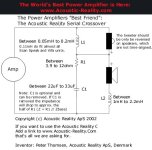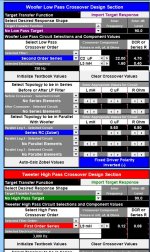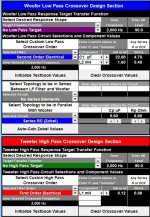I’ve never laid one out...
Connect L1, R1 and L2 together in a straight line.
The amp connects to the free end of L1 and the junction between R1 and L2.
The tweeter connects to the free end of L1 and the junction between L1 and R1.
The woofer connects to the junction between L1 and R1 and the free end of L2.
(Observe the tweeter and woofer polarities, i.e., ensure the + terminal of each goes to the junction between L1 and R1.)
Is this helpful in laying out the crossover?
Why does Acoustic Reality say this series crossover is an "amplifier's best friend"? Is it the lack of capacitors in the circuit?
Or does it have more to do with flattening the impedance spike at the crossover freq?
I have become quite curious about series crossovers for a 2.5 way, using some Wavecor 4 ohm woofers I have but keeping the overall impedance above about 4ohm (ideally up at 6-8ohm or so).
Or does it have more to do with flattening the impedance spike at the crossover freq?
I have become quite curious about series crossovers for a 2.5 way, using some Wavecor 4 ohm woofers I have but keeping the overall impedance above about 4ohm (ideally up at 6-8ohm or so).
I have doubts since the impedance tends to be lower this way. The impedance at lower frequencies is fairly dependent on the resistor value. The main effect of changing the resistor is setting the tweeter level. So a sensitive tweeter is useful, and it should preferably be more sensitive than (the woofer - baffle step) to keep the system impedance above half the woofer impedance.an "amplifier's best friend"? Is it the lack of capacitors in the circuit?
Without the cap missing in series with R1 in the same leg (Rabbitz' network has the cap as I am suggesting), the resistor there will get VERY hot as it is the amplifier load without the cap there. 100W heatsunk externally mounted resistors are recommended for best practices. It will also kill the output of the woofer as the resistor is directly in parallel with it without the cap. The cap should be 15-25uF range if you are looking to voice by ear.
The reason it is touted as amplifier's best friend is the resistive load the capless network makes.
The result of a series xover does not add the impedances for a higher load value. This is incorrect internet lore.
The reason it is touted as amplifier's best friend is the resistive load the capless network makes.
The result of a series xover does not add the impedances for a higher load value. This is incorrect internet lore.
The AR series xo tends to have a flatter impedance plot around the xo frequency rather than the usual roller coaster shape you get with other xo's. Most of mine fall within a 4 ohm envelope excluding the woofer Fs rise.
AllenB is correct about the tweeter sensitivity as if it's too close to the woofer sensitivity R1 becomes too low and the xo impedance drops dramatically. A few dB higher for the tweeter SPL is the aim.
An AR series is not going to help with impedance of the 2.5 way with 4 ohm woofers as the 0.5 woofer is still in parallel. OK for an MTM with woofers in series. I've seen a trick in the fullrange forum using a cap for a 0.5 woofer but never tried it.
AllenB is correct about the tweeter sensitivity as if it's too close to the woofer sensitivity R1 becomes too low and the xo impedance drops dramatically. A few dB higher for the tweeter SPL is the aim.
An AR series is not going to help with impedance of the 2.5 way with 4 ohm woofers as the 0.5 woofer is still in parallel. OK for an MTM with woofers in series. I've seen a trick in the fullrange forum using a cap for a 0.5 woofer but never tried it.
Troels Gravesen, who is a well known enthusiast in diy loudspeakers, had nothing good to say about the Acoustic Reality series crossover. He felt it plain didn't work well with most drivers.
Firstly, you need very well behaved drivers that for the bass, sound reasonable without any filtering at all beyond a bass coil. Which usually means plastic cones. For treble, they need to be robust enough to run on a single capacitor and a resistor for level adjust.
Second, some control of time alignment of the drivers is usually required.
Thirdly, you run into problems with the bass boost known as bafflestep, and impedance correction is usually necessary.
The late Jeff Bagby was a great theoretician and published this table of values for 8 ohm speaker filters:

I tried this in Boxsim 1.2 simulator and the results were impressive, albeit they might be bass light:

The circuit was this with visaton drivers and time alignment:

More detail:
https://www.diyaudio.com/community/threads/driver-for-b-o-cx50-3-25l-cabinet.377578/#post-6800634
You'll be very lucky if whatever drivers you have chosen work well on a first order circuit.
If you want to try Boxsim 1.2, it is here:
https://www.diyaudio.com/community/...-from-visaton-free.267787/page-2#post-7126272
I have never built a series filter, but have looked at them in simulation. Sorry if that takes you out of your depth. Best, Steve.
Firstly, you need very well behaved drivers that for the bass, sound reasonable without any filtering at all beyond a bass coil. Which usually means plastic cones. For treble, they need to be robust enough to run on a single capacitor and a resistor for level adjust.
Second, some control of time alignment of the drivers is usually required.
Thirdly, you run into problems with the bass boost known as bafflestep, and impedance correction is usually necessary.
The late Jeff Bagby was a great theoretician and published this table of values for 8 ohm speaker filters:
I tried this in Boxsim 1.2 simulator and the results were impressive, albeit they might be bass light:
The circuit was this with visaton drivers and time alignment:
More detail:
https://www.diyaudio.com/community/threads/driver-for-b-o-cx50-3-25l-cabinet.377578/#post-6800634
You'll be very lucky if whatever drivers you have chosen work well on a first order circuit.
If you want to try Boxsim 1.2, it is here:
https://www.diyaudio.com/community/...-from-visaton-free.267787/page-2#post-7126272
I have never built a series filter, but have looked at them in simulation. Sorry if that takes you out of your depth. Best, Steve.
I have seen that Acoustic Reality Series Crossover many times in past 10 years - as well as many variations, and always annoyed me...... isn't it odd no crossover point is ever indicated? How about tweeter and woofers - are they 4 ohm, 8 ohm? Those stated component values calculated for woofer or tweeters of a certain impedance, so what are they?
Understood standard 1st (or 2nd) series crossover have same component values as a 1st (or 2nd) order parallel, but that AR Series are not standard values, and appear to be 2nd order on woofer and 1st order on tweeter?
That AR website implies you can put this magical crossover on any 2 way speaker and it will be transformed into something special, regardless of crossover point...bah!
What gives, or am I just slow?
Understood standard 1st (or 2nd) series crossover have same component values as a 1st (or 2nd) order parallel, but that AR Series are not standard values, and appear to be 2nd order on woofer and 1st order on tweeter?
That AR website implies you can put this magical crossover on any 2 way speaker and it will be transformed into something special, regardless of crossover point...bah!
What gives, or am I just slow?
Attachments
Last edited:
Never fried a tweeter and all I have done the tweeter has 2nd order acoustic slopes or higher with tweeter more than 25dB down at Fs. One thing I will say is driver selection is important and I add a CR network to the woofer for various reasons.
Put some numbers into PCD or SCD by Bagby and see the behaviour with value changes.
Put some numbers into PCD or SCD by Bagby and see the behaviour with value changes.
Last edited:
Put some numbers into PCD or SCD by Bagby and see the behaviour with value changes.
I have and used the Bagby Crossover designer for quite some time. I assume I go by the 1st Order Series? If not, which one will get me the values of the AR for L1 and C1 or L2?
Again, I understand the 1st (2nd order) Parallel values will do for the 1st (2nd order) Series, and the Bagby calc Series Crossover (with Zeta =1) yields same values as 1st order Butterworth Parallel, but I never come anywhere close to the AR values.
Will the standard listed values on the AR series give a crossover point anywhere near 1k for my 8 ohm B&C250 compression driver / horn and 4 ohm (total) pair of Eminence 15A woofers?
Maybe my tweeters and woofers are not well suited for the AR crossover?
The main issue with series crossovers, is that you need drivers with very well behaved Le(x), Le(I) and BL(x).
Otherwise the ENTIRE crossover shifts.
If that's a sound you're looking for, great.
If you're looking for something more transparent and proper sound reproduction, not so much.
Otherwise the ENTIRE crossover shifts.
If that's a sound you're looking for, great.
If you're looking for something more transparent and proper sound reproduction, not so much.
The best advice I can give to you is to ditch that silly crossover, and design (with measurements!) a proper serial or parallel crossover, using any free crossover simulation software.Hello, I’m looking at trying the Aciustic Reality series crossover. I’ve never laid one out though. Looks like just three components. Can anyone help me?
Last edited:
In PCD you have to select Series Two-way and then load wiring configuration. Woofer select 2nd order series and tweeter 1st order series. See an example for PCD and SCD which has a zobel as well which is not part of the original AR design.I have and used the Bagby Crossover designer for quite some time. I assume I go by the 1st Order Series? If not, which one will get me the values of the AR for L1 and C1 or L2?
It's only one type of filter using L, C and R and has advantages and disadvantages. With this type of filter any changes to say C1 and L2 also effects the behaviour of the tweeter. It's important to have a very low DCR in L1 and should be <5% of the tweeter Re (for protection).
Attachments
Thank for the help Rabbitz!
OK, have not used that other Bagby crossover calculator...I will have to check it out (I use the older calc all the time)
Parallel is so easy to understand...Series, well, not so much.
To make Series Crossovers more confusing is Broskie's take on first order - second order series that have same component values, where the expectation is for the components to halve going from 1st to 2nd order Series...
TubeCAD
And to confuse further, I remember Thiel speaker were into series crossovers, and designer noted to not bother with first order series unless your tweeter can properly work two octaves lower. That kills my chosen 1khz series crossover point for compression driver/horn, as it can not work at 250hz...and I really want to stay with two way...
Maybe best to stick with Active Crossover on these speakers...
OK, have not used that other Bagby crossover calculator...I will have to check it out (I use the older calc all the time)
Parallel is so easy to understand...Series, well, not so much.
To make Series Crossovers more confusing is Broskie's take on first order - second order series that have same component values, where the expectation is for the components to halve going from 1st to 2nd order Series...
TubeCAD
And to confuse further, I remember Thiel speaker were into series crossovers, and designer noted to not bother with first order series unless your tweeter can properly work two octaves lower. That kills my chosen 1khz series crossover point for compression driver/horn, as it can not work at 250hz...and I really want to stay with two way...
Maybe best to stick with Active Crossover on these speakers...
- Home
- Loudspeakers
- Multi-Way
- Layout help for series crossover


